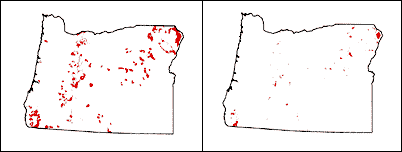|
Our National Forests
The Vanishing Forest Protection Plan
Maps Show Most Wild and Roadless
Forests Still at Risk
Sept.
2000--An analysis of the Forest
Service's proposed roadless forest protection plan, conducted by
The Wilderness Society and the Heritage Forests Campaign, suggests
that between 61 and 87 percent of the roadless forest areas that
President Clinton instructed the Forest Service to protect could
still be logged using existing technology.
Experts note that timber can be harvested anywhere within one
mile of an existing road using chainsaws, helicopters, crane-like
forwarders, and sky cable systems.
In October of 1999, President Clinton directed the U.S. Forest
Service to draft a wild forest protection policy that would "protect
these priceless, back-country lands."
In May of 2000, however, after receiving over 500,000 citizen
comments asking for an end to new road construction and logging in
all remaining roadless national forest areas, the U.S. Forest
Service issued a draft environmental impact statement whose
"preferred alternative" would allow continued logging so long as it
did not require new road construction. The Tongass rainforest in
Alaska, the largest national forest in the U.S. and one of the last
temperate rainforests in the world, was completely exempt under the
Forest Service's "preferred alternative."
| Click
here for larger version and maps of other
states. | 
| Left Map: All inventoried roadless
areas in the state of Oregon. |
Right Map: Inventoried roadless
areas in Oregon that are too far from an existing road to log
using existing technologies. |
| Said Ken Rait, Director of the Heritage Forests Campaign,
"Wild forest protection starts when the chainsaws stop.
Under the Forest Service's proposal there is no guarantee that
these priceless areas would receive the protection they
deserve. The final policy must explicitly prohibit logging in
our remaining wild forests to deliver the type of protection
the President envisions and the public overwhelmingly
supports."
"15% is not real protection," said Bill Meadows,
President of The Wilderness Society. "With as much as 85%
of the wild forests lands still vulnerable to roadless logging
technology, the current Forest Service proposal has loopholes
large enough to drive a logging truck through. A cable system
can clear cut a mountain with startling efficiency, while
helicopter logging has proven profitable even at higher
altitudes. Clearly substantial logging can still occur. This
is not compatible with President Clinton's vision of last
October, and it certainly isn't compatible with a lasting
legacy of wild forests."
 | |





